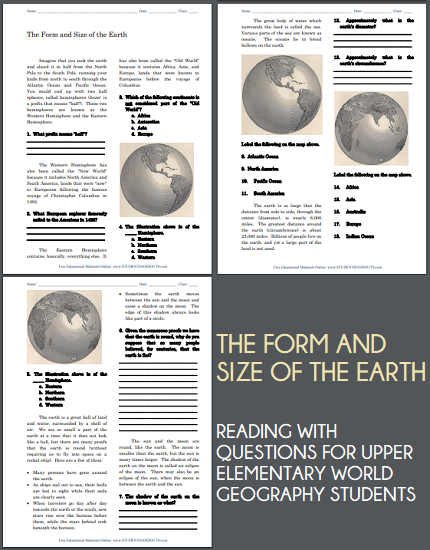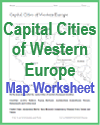| The Form and Size of Earth Worksheet |
|---|
| www.studenthandouts.com ↣ World Geography ↣ Geography Worksheets |
 |
   |
|
Students are asked to read the text and answer questions. Click here to print.
Answer Key:
Imagine that you took the earth and sliced it in half from the North Pole to the South Pole, running your knife from north to south through the Atlantic Ocean and Pacific Ocean. You would end up with two half spheres, called hemispheres (hemi- is a prefix that means "half"). These two hemispheres are known as the Western Hemisphere and the Eastern Hemisphere. The Western Hemisphere has also been called the "New World" because it includes North America and South America, lands that were "new" to Europeans following the famous voyage of Christopher Columbus in 1492. The Eastern Hemisphere contains, basically, everything else. It has also been called the "Old World" because it contains Africa, Asia, and Europe, lands that were known to Europeans before the voyage of Columbus. The earth is a great ball of land and water, surrounded by a shell of air. We see so small a part of the earth at a time that it does not look like a ball, but there are many proofs that the earth is round (without requiring us to fly into space on a rocket ship). Here are a few of them: Many persons have gone around the earth. As ships sail out to sea, their hulls are lost to sight while their sails are clearly seen. When travelers go day after day towards the north or the south, new stars rise over the horizon before them, while the stars behind sink beneath the horizon. Sometimes the earth moves between the sun and the moon and casts a shadow on the moon. The edge of this shadow always looks like part of a circle. The sun and the moon are round, like the earth. The moon is smaller than the earth, but the sun is many times larger. The shadow of the earth on the moon is called an eclipse of the moon. There may also be an eclipse of the sun, when the moon is between the earth and the sun. The great body of water which surrounds the land is called the sea. Various parts of the sea are known as oceans. The oceans lie in broad hollows on the earth. The earth is so large that the distance from side to side, through the center (diameter), is nearly 8,000 miles. The greatest distance around the earth (circumference) is about 25,000 miles. Billions of people live on the earth, and yet a large part of the land is not used. |
| www.studenthandouts.com ↣ World Geography ↣ Geography Worksheets |








